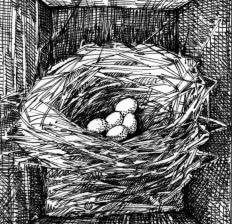
When the male bluebird first arrived in my front yard, I adopted a new routine. Whenever I reached the living room, I would glance out the big window to the north end of the garden, where a homemade birdhouse stood, and report on all aspects of the bluebird’s behavior. Whether he perched on the birdhouse, stalked through the brown grasses along the edge of the garden fence, or caroled from the flowering crab – all this was grist for my mill.
He was the purest blue, bluer than the bluest May sky, and his residence in my garden gave me delight. It was the perfect place. The earth was brown and rich and would produce a bumper crop of insects. The grass on the western side of the garden was wild and untended, a splendid nursery for grasshopper nymphs and caterpillars. To the south of the garden was a marsh bordered by red and black raspberry canes and patches of wild strawberries. Beyond the marsh were pin cherries and shadbush. There were enough insects and berries in our front yard for two broods of bluebirds, maybe three.
The bluebird was sleek and stoop-shouldered as he perched on the top of the birdhouse, a well-fed individual. His cheeks, head, back, wings, and tail were bright blue. His throat, breast, and flanks were reddish brown, the color of Georgia clay. His belly was white. He had a thin black bill and penetrating black eyes. His slightest movement caught my attention. He came to the garden from the South – Maryland, Delaware, Virginia, the Carolinas, or maybe Bermuda – and began to stake claim to our entire front yard. My yard was his. Nothing seemed to bother the bluebird, for he went about his business with complete confidence. Even our dog, whose wild peregrinations left ruts in the meadow, was just another distraction.
I don’t remember when I first saw the female, but when I confirmed her presence, I spread the news like an expectant parent. She was interested in the male’s rich warble and immaculate appearance, and in the birdhouse as well. It was, after all, the perfect place to live. For several days the bluebird attended his mate, bringing her tidbits from the meadow and the marsh. Each bird took turns inspecting the birdhouse.
Eventually, both birds brought grass into the house. She did most of the work while he flitted from post to post and back again. Sometimes he stopped to sing three or four sweet gurgling notes, but more often he paraded around the front yard keeping a vigilant watch for tree swallows, house sparrows, and starlings, all of which may take over a bluebird house and evict the original tenants.
All went well for the birds; it was, after all, the perfect place. On May 16, five pale-blue eggs filled the soft nest cup. Some days I never saw the parents. Most days I never heard them. I didn’t mind, though; five warm eggs rested in the nest cup. Thirteen days after the clutch was completed, five baby bluebirds, gray like mice, broke through their eggshells and huddled in the nest cup. Whenever I scratched the nest box, their little heads shot up, mouths agape and flashing a deep yellow.
The chicks prospered. Their eyes opened in five days, and from that point on their response to me was lukewarm. After the eighth day, they cringed in the nest cup whenever I paid them a visit. The adult birds became just as wary. (Unlike their neighbors the tree swallows and chickadees, who sat tight with their brood whenever I inspected the nestbox, the bluebirds bolted whenever the door opened.) Even at night, when I dumped the kitchen compost, the male or female spooked.
By day seventeen the chicks were close to fledging. But then tragedy struck. A small thin mammal, perhaps a weasel, had squeezed into the box. All that remained of the brood was a pile of blue-gray wing feathers – the lower vanes still pressed in their sheaths – and the headless carcass of a chick opened lengthwise down the breast, the vital organs removed. A pair of untried wings hung from the carcass.
I was devastated, but the adult bluebirds took their loss in stride. There was no piteous mourning. They collected insects and berries in the usual manner – dropping to the lawn, to the woodpile, to the garden – but without chicks to feed, they consumed their catch themselves. For more than a month the bluebirds flitted around the front yard, from garden to stonewall to flowering crab. There was plenty of food. It was, after all, the perfect place.

